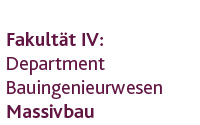Raum: PB-A 108
 +49 271 740-4029
+49 271 740-4029
 metje@bau.uni-siegen.de
metje@bau.uni-siegen.de
Charakterisierung der Orientierung von Stahlfasern in ultrahochfestem Beton durch Ultraschallmessung
Forschungsschwerpunkt
Mechanik des Faserbetons und faserverstärkten Stahlbetons
Bearbeiter
Dipl.-Ing. Benjamin Ankay (Lehrstuhl für Baustatik)
Kevin Metje, M.Sc.
Projektpartner
Lehrstuhl für Baustatik, Department Bauingenieurwesen, Universität Siegen
Projektbeschreibung

Ultrasonic technology has proven to be a reliable non-destructive method for testing engineering applications. Especially for complex composites, like fibre-reinforced plastics or fibre-reinforced concrete, the pulse velocity method can be used to analyse the fibre-induced anisotropy.
In a research project, ultrasonic testing was applied to investigate the fibre orientation in ultra-high performance fibre-reinforced concrete (UHPFRC). The orientation and distribution of fibres significantly influence the bearing behaviour and are thus important parameters when designing UHPFRC members. In ultrasound experiments, the main orientation of the fibres in UHPFRC specimens was determined by a method based on analysing the wave velocities of polarised shear waves. Using this method, the shear wave velocities vs were calculated for different rotation angles. Therefore, the transducer was rotated from a stipulated starting position (θ = 0°) in 15° increments and the associated relative changes in the wave velocity with respect to the starting position were recorded (Fig. 1). Finally, this measurement procedure results in a diagram as given exemplarily in Fig. 2. Here, the percentage change in the shear wave velocity Δvs/vs,0 is given as a function of the rotation angle θ. Based on this diagram, the maximum wave velocity change and the corresponding rotation angle θmax were determined for each specimen. The latter quantity describes the expected predominant fibre alignment at the measuring point.
Afterwards, specimens with particularly high differences in the relative wave velocities were cut perpendicular and parallel to the predominant fibre alignment predicted by ultrasonic testing and the actual orientation of the fibres in the cross-sections was evaluated by an optoanalytical method (Fig. 3).
The evaluation of the results obtained with ultrasonic and optoanalytical method confirms that the method is generally suitable for qualitatively determining the predominant fibre alignment in UHPFRC. However, a quantitative assessment for a specific coefficient of orientation for individual specimens depends on different factors, which may be investigated and evaluated in further studies. The main influencing factors are inhomogeneities, such as air voids, aggregate, etc. as well as heterogeneous fibre distribution in the concrete. Furthermore, the coupling condition between the transducer and the specimen’s surface is influencing the ultrasonic measurement.
The present study may be considered as a meaningful starting point for future work in this research field. For example, new ultrasonic methods using air-coupled transducers or surface acoustic wave (SAW) methods can be adopted to overcome some drawbacks of the present method and to automate the measuring procedure.
Publikationen
ANKAY, B.; METJE, K.; MÖNIG, T.; ZHANG, C.; LEUTBECHER, T., 2019. Ultrasonic characterisation of steel fibre orientation in ultra-high performance concrete. In: AMA Service GmbH, Hrsg. Tagungsband 20. GMA/ITG-Fachtagung Sensoren und Messsysteme 2019. Nürnberg, 25. und 26. Juni 2019. Wunstorf: AMA Service GmbH, S. 310-317. ISBN 978-3-9819376-0-2. doi:10.5162/sensoren2019/4.1.4
